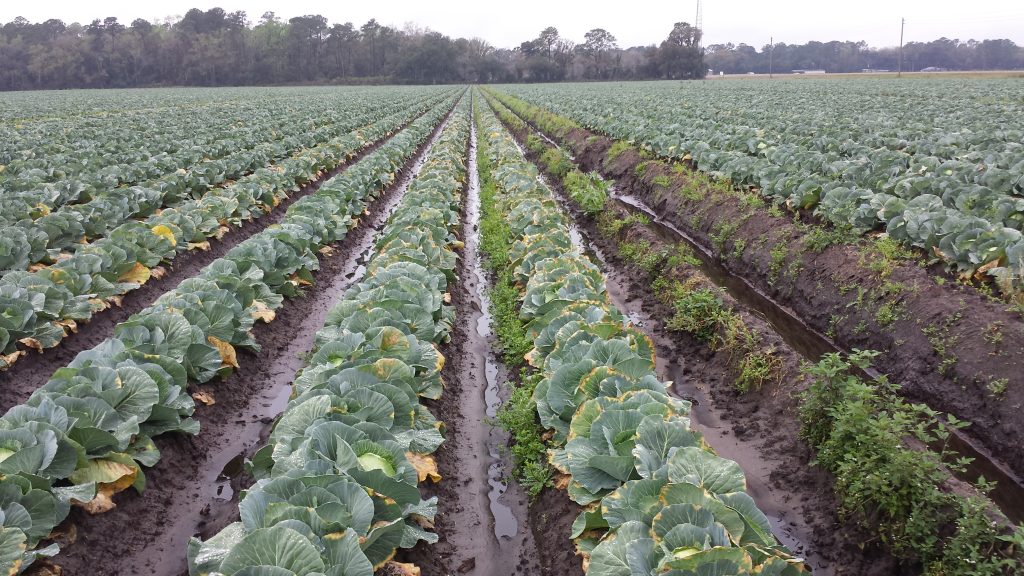Clemson Cooperative Extension released some diseases that cole crop growers need to be on the look out for this spring.

Cole crops, such as broccoli, Brussels sprouts, cabbage and cauliflower, are easily grown in South Carolina. Tips for growing healthy cole crops in the garden are available in HGIC 1301, Broccoli, HGIC 1326, Cauliflower and HGIC 1303, Cabbage & Chinese Cabbage. Several disease problems commonly affect these plants, especially when resistant varieties are not planted. Some of the more common problems are covered here, including root and stem rots of young plants, black rot, downy mildew and viruses.
Pythium Damping-Off
This disease commonly affects seeds and young transplants and is caused by the soil-borne fungus Pythium species. Infected seeds decay in the soil. Seedlings and young transplants will “damp-off” or rot at the soil line, before they eventually collapse and die.
Prevention & Treatment: Cultural controls include planting on raised beds and providing good drainage. Start seeds in commercial potting soil, not in garden soil. Use new potting soil and new or thoroughly cleaned and dis-infested containers and trays. Wash used containers with soapy water to remove all traces of old soil mix, and then briefly submerse containers in a 10% bleach solution. Allow to dry before planting in containers.
If disease has been severe enough in the past to warrant control, the biocontrol fungicide, Bacillus subtilis QST 713, can be used before or at the time of seeding. It can be used for treatment of seedlings in trays or young transplants in the garden.
Downy Mildew
This disease is caused by the fungus Peronospora parasitica and can attack both seedlings and mature vegetable plants. Infected plants develop a gray mold on the lower leaf surface. The upper leaf surface of infected plants first turns yellow and then may turn brown or necrotic. Leaves wither and die. Symptoms differ from powdery mildew in that the downy mildew fungus grows only on the lower surface of the leaf. Development of the disease is favored by moist conditions.
Prevention & Treatment: Use varieties with resistance or tolerance to this disease. Rotate with crops other than cole crops or greens. Remove plant debris immediately after harvest. Use wide plant spacing to promote drying of leaves. Avoid wetting the leaves when watering.
If disease becomes severe enough to warrant chemical control, chlorothalonil will give good control and copper fungicides will give fair control. Spray every 7 to 10 days after transplants are set. Make sure that the lower leaf surface is covered with fungicide. Do not apply copper when temperatures are above 90 °F. Wait 7 days after spraying before harvesting if using chlorothalonil or mancozeb.
Alternaria Leaf Spot
This disease is caused by the fungus, Alternaria species, and occurs during warm, moist conditions. On seedlings, the symptoms are small dark spots on the stem that can cause damping-off or stunting of the plant. On older plants, the bottom leaves are infected first with brown circular spots on the leaves. Spots have characteristic concentric rings (target spots). Infected leaves soon turn yellow and drop. Bright sunshine, frequent dews or showers, and temperatures between 60 and 90 °F favor disease development.
Prevention & Treatment: Remove and destroy all crop debris immediately after harvest, since this disease overwinters on plant residue. It is easily spread by tools, wind, splashing water or insects. Seed treatment and rotation with crops other than cole crops or greens will also reduce disease. If disease is severe enough to warrant chemical control, chlorothalonil will give good control and copper fungicides will give fair to poor control. Spray every seven to 10 days after transplants are set. Wait 7 days after spraying before harvest if using chlorothalonil.
For full story, see Clemson fact sheet.
Clemson Cooperative Extension









